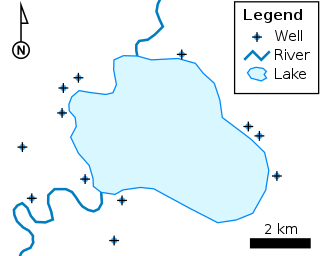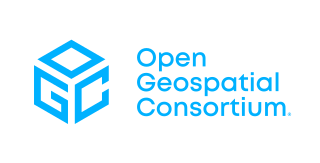
The International Organization for Standardization is an independent, non-governmental, international standard development organization composed of representatives from the national standards organizations of member countries. Membership requirements are given in Article 3 of the ISO Statutes.

The Geography Markup Language (GML) is the XML grammar defined by the Open Geospatial Consortium (OGC) to express geographical features. GML serves as a modeling language for geographic systems as well as an open interchange format for geographic transactions on the Internet. Key to GML's utility is its ability to integrate all forms of geographic information, including not only conventional "vector" or discrete objects, but coverages and sensor data.
A coverage is the digital representation of some spatio-temporal phenomenon. ISO 19123 provides the definition:
Catalogue Service for the Web (CSW), sometimes seen as Catalogue Service - Web, is a standard for exposing a catalogue of geospatial records in XML on the Internet. The catalogue is made up of records that describe geospatial data, geospatial services, and related resources.

In computational geometry, the minimum bounding rectangle (MBR), also known as bounding box (BBOX) or envelope, is an expression of the maximum extents of a two-dimensional object (e.g. point, line, polygon) or set of objects within its x-y coordinate system; in other words min(x), max(x), min(y), max(y). The MBR is a 2-dimensional case of the minimum bounding box.
Geospatial metadata is a type of metadata applicable to geographic data and information. Such objects may be stored in a geographic information system (GIS) or may simply be documents, data-sets, images or other objects, services, or related items that exist in some other native environment but whose features may be appropriate to describe in a (geographic) metadata catalog.
A spatial data infrastructure (SDI), also called geospatial data infrastructure, is a data infrastructure implementing a framework of geographic data, metadata, users and tools that are interactively connected in order to use spatial data in an efficient and flexible way. Another definition is "the technology, policies, standards, human resources, and related activities necessary to acquire, process, distribute, use, maintain, and preserve spatial data". Most commonly, institutions with large repositories of geographic data create SDIs to facilitate the sharing of their data with a broader audience.
NATO Standardization Agreement (STANAG) 7074, Digital Geographic Information Exchange Standard (DIGEST), is a military standard for the exchange of geographic information. It was developed by the Defence Geospatial Information Working Group (DGIWG).
A feature, in the context of geography and geographic information science, is a discrete phenomenon that exists at a location in the space and scale of relevance to geography; that is, at or near the surface of Earth. It is an item of geographic information, and may be represented in maps, geographic information systems, remote sensing imagery, statistics, and other forms of geographic discourse. Such representations of features consist of descriptions of their inherent nature, their spatial form and location, and their characteristics or properties.

Metadata is "data that provides information about other data", but not the content of the data itself, such as the text of a message or the image itself. There are many distinct types of metadata, including:
Observations and Measurements (O&M) is an international standard which defines a conceptual schema encoding for observations, and for features involved in sampling when making observations. While the O&M standard was developed in the context of geographic information systems, the model is derived from generic patterns proposed by Fowler and Odell, and is not limited to geospatial information. O&M is one of the core standards in the OGC Sensor Web Enablement suite, providing the response model for Sensor Observation Service (SOS).
A metadata standard is a requirement which is intended to establish a common understanding of the meaning or semantics of the data, to ensure correct and proper use and interpretation of the data by its owners and users. To achieve this common understanding, a number of characteristics, or attributes of the data have to be defined, also known as metadata.
The Spatial Archive and Interchange Format was defined in the early 1990s as a self-describing, extensible format designed to support interoperability and storage of geospatial data.
GeoAPI is free software providing a set of Java interfaces for GIS applications. GeoAPI interfaces are derived from the abstract model and concrete specifications published collaboratively by the International Organization for Standardization (ISO) in its 19100 series of documents and the Open Geospatial Consortium (OGC) in its abstract and implementation specifications. GeoAPI provides an interpretation and adaptation of these standards to match the constraints and usages of the target programming language. The international standards translated to Java interfaces are:

The Open Geospatial Consortium (OGC), an international voluntary consensus standards organization for geospatial content and location-based services, sensor web and Internet of Things, GIS data processing and data sharing. It originated in 1994 and involves more than 500 commercial, governmental, nonprofit and research organizations in a consensus process encouraging development and implementation of open standards.
The Web Coverage Processing Service (WCPS) defines a language for filtering and processing of multi-dimensional raster coverages, such as sensor, simulation, image, and statistics data. The Web Coverage Processing Service is maintained by the Open Geospatial Consortium (OGC). This raster query language allows clients to obtain original coverage data, or derived information, in a platform-neutral manner over the Web.
ISO/IEC JTC 1/SC 24 Computer graphics, image processing and environmental data representation is a standardization subcommittee of the joint subcommittee ISO/IEC JTC 1 of the International Organization for Standardization (ISO) and the International Electrotechnical Commission (IEC), which develops and facilitates standards within the field of computer graphics, image processing, and environmental data representation. The international secretariat of ISO/IEC JTC 1/SC 24 is the British Standards Institute (BSI) located in the United Kingdom.
GeoPackage (GPKG) is an open, non-proprietary, platform-independent and standards-based data format for geographic information systems built as a set of conventions over a SQLite database. Defined by the Open Geospatial Consortium (OGC) with the backing of the US military and published in 2014, GeoPackage has seen widespread support from various government, commercial, and open source organizations.
Geographic data and information is defined in the ISO/TC 211 series of standards as data and information having an implicit or explicit association with a location relative to Earth. It is also called geospatial data and information, georeferenced data and information, as well as geodata and geoinformation.




